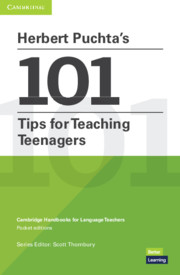 Herbert Puchta's 101 Tips for Teaching Teenagers
Herbert Puchta's 101 Tips for Teaching Teenagers Published online by Cambridge University Press: 28 October 2023
I use the term ‘classroom culture’ as discussed by Breen (1986) in addressing the complexity of the interactive and social aspects of the classroom; he portrays this complexity as a coral reef with its surface hiding a multiplicity of life forms and challenges. ‘Most often the flow of classroom life is actually under the surface. What is observable is the rim of a socio-cognitive coral reef! Classroom life seems to require that many learners spend surprising amounts of time doing little, whilst a teacher spends equally surprising amounts of time trying to do too much.’ Hopefully, the tips in this section will help you discover some of the hidden challenges, and explore ways of meeting them successfully (without having to do too much!).
24 Create a classroom culture your learners want to belong to
25 Show learners you care for their physical well-being
26 Establish the ground rules together
27 Inject some light-hearted fun into the lessons
28 Help learners cope with stress
29 Deal with errors wisely
30 Help your learners learn from their mistakes
31 Ask for feedback
32 Take learners’ emotions seriously
33 Make learners feel they are in control
24 Create a classroom culture your learners want to belong to
The way you interact with your learners has a significant impact on how welcome they feel.
As a young teacher, I was told by a 14-year-old who I had taught for several years that she had thought at first that I wasn't very nice because when I entered the classroom for my very first lesson with her class, I ‘looked grumpy’. I was surprised because I’m not normally seen as bad-tempered. With hindsight, she had probably caught me at a moment when I was deep in thought, unaware of the difference a smile would have made to my learners.
• You never get a second chance to create a first impression. In a class for the first time, smile and make eye contact with all learners.
• Make sure you know learners’ names, and use them. Use mnemonic techniques to memorise them, e.g. create an association or rhyme between a person's name and an object the name reminds you of, then a picture that fuses the two. If a learner is called Sue, think of, e.g. Sue in a zoo, and remember a picture of her climbing a giraffe's (super-long) neck.
To save this book to your Kindle, first ensure [email protected] is added to your Approved Personal Document E-mail List under your Personal Document Settings on the Manage Your Content and Devices page of your Amazon account. Then enter the ‘name’ part of your Kindle email address below. Find out more about saving to your Kindle.
Note you can select to save to either the @free.kindle.com or @kindle.com variations. ‘@free.kindle.com’ emails are free but can only be saved to your device when it is connected to wi-fi. ‘@kindle.com’ emails can be delivered even when you are not connected to wi-fi, but note that service fees apply.
Find out more about the Kindle Personal Document Service.
To save content items to your account, please confirm that you agree to abide by our usage policies. If this is the first time you use this feature, you will be asked to authorise Cambridge Core to connect with your account. Find out more about saving content to Dropbox.
To save content items to your account, please confirm that you agree to abide by our usage policies. If this is the first time you use this feature, you will be asked to authorise Cambridge Core to connect with your account. Find out more about saving content to Google Drive.